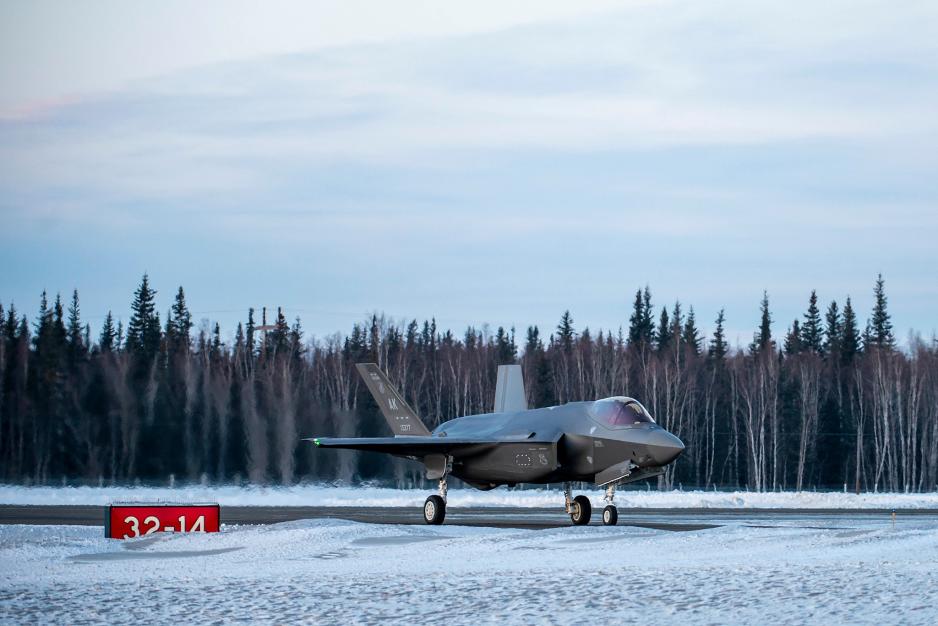New US Arctic Strategy Foreshadows Increasing Hurdles for Cooperation in a More Complex Region

An F-35A taxis during at Eielson Air Force Base, Alaska. (Source: US Air Force/Staff Sgt. Kaylee Dubois)
The new US Arctic strategy suggests that addressing the adverse impacts from climate change and maintaining international cooperation despite increasing strategic competition vis-à-vis Russia and China will be key challenges in the region over the next decade.
On Friday the United States released a new national Arctic strategy, the first update since 2013, setting the country’s priorities for the coming 10 years.
The strategy suggests four key pillars of US Arctic policy: Security, climate change and environmental protection, sustainable development, and international cooperation and governance.
According to the US rising strategic competition in the region, a trend which it sees further accelerated through the Russian invasion of Ukraine, is a key aspect of Arctic geopolitics going forward.
As a result of these trends the new strategy suggests that the US will continue to maintain and likely expand and advance its military presence in the Arctic, including through regular exercises bilaterally with partners, such as Norway, or as part of NATO.
The Coast Guard’s presence in the region will also be expanded in part through an enlarged icebreaker fleet.
The document also places an emphasis on the challenges arising from climate change in the region and the need for new investments and sustainable development in the region.
Russia and China main competitors
The strategy specifically singles out Russia and China as the two main competitors in the Arctic and highlights their recent activities in the Arctic in light of the growing strategic importance.
Specifically, the US highlights Russia’s vastly increased spending in both economic projects and military presence in the region, including military bases and airfields, defensive and offensive missile systems, and upgrades to its Northern Fleet, including higher frequency and scale of military exercises.
The US also notes that China has doubled its investments in the region over the past decade including an expanded icebreaker fleet, military activity in the region and greater scientific engagement, often dual-use with possible military or intelligence applications.
“China is the only non-Arctic country mentioned in the document. And it is painted in a fairly antagonistic light. Whereas earlier reports and threat assessments, such as those by the Department of Defense, have been more agnostic about Chinese military activities or interest in the region, the newest strategy states more confidently that China has used its civilian research presence for intelligence and military purposes in the Arctic,” explains Trym Aleksander Eiterjord, research associate and expert on China’s Arctic policy at The Arctic Institute.
The new national strategy also, as in the past, does not recognize China’s claim of being a “near-Arctic state” and the US categorizes China as a non-Arctic country.
“For Beijing, this strategy is yet another signal that it is facing a very different and ultimately less welcoming Arctic, with the US seeking to regain its presence in the region and NATO expanding northward,” concludes Eiterjord.
Ukraine war changes Arctic dynamic
As a result of the unprovoked war against Ukraine, the US says that “government-to-government cooperation with Russia” has become virtually impossible in the Arctic in the short- and medium-term.
But it also hopes that over the coming decade some kind of cooperation in international fora may become possible again.
However, the document remains vague about how international cooperation with Russia in the Arctic Council or elsewhere can eventually be restarted.
“Multilateral complexity is already a reality for Arctic international issues, but made acute by the current impossibility of cooperation with Russia in the Arctic Council. Can the (relatively) well-functioning science-policy interface typically at the Arctic Council be adapted to a more global and complex setting,” asks Elana Wilson Rowe, research professor at NUPI, the Norwegian Institute of International Affairs.
The document also establishes a direct link between western economic sanctions against Russia and how these sanctions will likely affect the country’s Arctic economic projects and military modernization efforts.
Russia’s flagship liquefied natural gas Arctic LNG 2 has faced a number of setbacks due to western partners exiting the joint-venture with Novatek.
Devil is in the details
As so often with high-level policies, the effectiveness of the new national strategy will largely depend on the ability of branches of the US government to allocate sufficient funding to meet policy goals.
In the case of the US Coast Guard, it struggled for a decade to secure the budgetary considerations necessary to begin renewing its aging icebreaker fleet.
And even with sufficient funding granted the first new icebreaker will not enter into service until 2026, at the earliest.
The document also leaves unanswered the question of how the new strategy will be implemented through actions by different branches of the US government.
Here future updated Arctic strategies by the US Department of Defense and the US Coast Guard will need to highlight priorities in more fine-grained detail.



